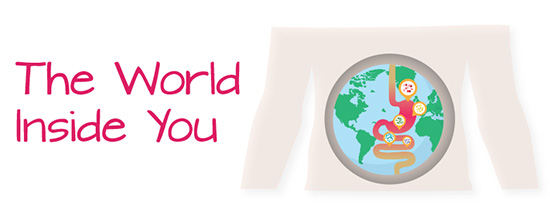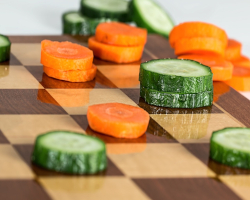
Illustrated by: Shireen Dooling, Dr. Biology
If you were to count the number of cells that make up your body and the number of microbes that live inside your gut, which would be higher? You might think that there has to be way more of you. In reality, the number of microorganisms that live inside our guts roughly equals the number of cells that make up our bodies!
The gut microbiome is what we call the community of all the organisms that live inside of us. We are learning more and more on how important of a role the gut microbiome plays in our health. But how long have they been traveling along with us? And as humans have evolved over time, did the microbes living inside of us change as well? These are some of the questions Taichi Suzuki is investigating.
Ancient hitchhikers

The gut microbiome is made up of various species of bacteria, viruses, fungi, and archaea. When most people hear the words “bacteria” and “virus,” they might think of disease and sickness. But the microbes that live in our guts often have a mutualistic relationship with us.
Our gut microbes help us break down fiber, and they create essential vitamins we need to live. They can also signal to the rest of the body when something is wrong. In return, these microbes get a steady supply of food and get to live in a fairly stable environment. This special habitat of the gut has led to unique adaptations in the microbes that live inside it. Many of these changes allowed them to thrive in the gut, but that wasn’t the only difference. Suzuki found something odd about the microbes which have stuck with us the longest. Their genomes shrunk! Over time, it seems they didn't need as many genes as they did at first to survive in the gut. That steady environment let them downsize their instructions.
This isn't to say that your gut is always the same. The residents that live in your gut can change depending on many factors. The factor with the most influence is your diet. These microbes rely on what you put in your gut to get energy, and not all food sources are equal. As you favor one type of food in your diet, the microbes that can more readily digest those foods will grow in number while others may decline. Additionally, these tiny organisms notice who is nearby and can make your body react. Microbes that don’t belong can also cause illnesses like food poisoning.
So where do all of these microbes come from? We first encounter microbes when we come out of the womb from those around us. This happens over generations… the microbes we have come from the ones our parents have, and they got theirs from their parents, and so on. One of the big discoveries Suzuki has made is that this evolutionary chain of microbes can be traced back to the origin of humans in Africa. Nearly half of the microbes in our gut have changed with us as we’ve evolved, a trend that is called “co-diversification.”

Once you are born, you will gradually gain more microbes through milk or other liquids. After you make the move to more solid foods, this community grows to accommodate your new energy sources. Your microbiome will continue to change slightly throughout your life, based on what’s in your gut.
No gut microbiome is an island
Suzuki is looking deeper into how our microbes changed along with humans. Across the globe, humans have mostly the same species of microbes. However, when we look more closely, we see that ethnic groups may have their own unique strains of these species. This is due to the gradual migration of humans over a long period of time. As some groups moved away, the microbes were only passed between the humans that were living together. Over time though, our ability to move across the world shrunk to hours instead of weeks or months. As people’s diets adjust to the new areas they live in, their microbial communities change too.
This is important because our bodies aren’t used to rapid changes in the microbiome. You may have heard you should not drink water or try new foods if you’re visiting another country or continent. This is because as you get further away from your home the more varied strains of microbes you encounter. Introducing new strains and species into your gut can have drastic influences on your health.
Suzuki hopes to focus his work around what is called an "evolutionary mismatch". In this case, this is the way that the new microbes in your gut differ from what your body (and ancestors) evolved with and are used to. Inflammation can occur when there is a prolonged mismatch. The cells of your gut are used to looking for specific chemicals from the microbes it knows. If new or too many chemicals come from foreign microbes in your gut, your body might react in unexpected ways.

Your immune system might even react to these new microbes as invaders in your body. It will then release immune cells which can cause inflammation. Studies have shown that chronic inflammation can result in many health problems. These effects can be seen in immigrants, who tend to have higher rates of gut inflammation than others. Suzuki wants to know if we can treat this by testing for a mismatch and giving therapy based on the microbiome you inherit.
One of the current treatments for issues with the gut microbiome is using what’s known as a fecal transplant. In this case, you take the purified bacteria from one person with a healthy gut and give those bacteria to a patient with an unhealthy gut. This can help adjust the microbiome… but how do you work around the evolutionary mismatch? This is a big question Suzuki hopes to answer on his path to understand the microbiome.
Read more about: The World Inside You
Bibliographic details:
- Article: The World Inside You
- Author(s): Christopher Albin-Brooks
- Publisher: Arizona State University School of Life Sciences Ask A Biologist
- Site name: ASU - Ask A Biologist
- Date published: 5 Jun, 2024
- Date accessed:
- Link: https://askabiologist.asu.edu/explore/evolution-gut-microbiome
APA Style
Christopher Albin-Brooks. (Wed, 06/05/2024 - 09:56). The World Inside You. ASU - Ask A Biologist. Retrieved from https://askabiologist.asu.edu/explore/evolution-gut-microbiome
Chicago Manual of Style
Christopher Albin-Brooks. "The World Inside You". ASU - Ask A Biologist. 05 Jun 2024. https://askabiologist.asu.edu/explore/evolution-gut-microbiome
Christopher Albin-Brooks. "The World Inside You". ASU - Ask A Biologist. 05 Jun 2024. ASU - Ask A Biologist, Web. https://askabiologist.asu.edu/explore/evolution-gut-microbiome
MLA 2017 Style

Much of Suzuki’s research has been looking at the gut microbiomes of mice. Image credit Taichi Suzuki.
Be Part of
Ask A Biologist
By volunteering, or simply sending us feedback on the site. Scientists, teachers, writers, illustrators, and translators are all important to the program. If you are interested in helping with the website we have a Volunteers page to get the process started.
